What if I told you a play scored a touchdown on 60% of the times its ran? Now what if I told you that it required very little practice time, was easy to run, showed a new look to the defense, and stretched the defense in a way most of Notre Dame’s other plays don’t? Now some of this is over blown by small sample size (3/5 went for touchdowns) and being run primarily in the red zone, but others are grounded firmly in fact. In this article I will talk about one of my favorite run plays: the speed option.
What is the speed option?
Picture from Rich Rodriguez’s West Virginia Playbook
The speed option is a running play where the quarterback runs toward an unblocked perimeter defender “the read key” with the running back trailing towards the edge of the field. If the read key tries to attack the quarterback, he pitches the ball to the running back, likewise if the read key plays the running back, the quarterback cuts up field to the vacated space. If the quarterback is not athletic the read key is often the end man line of scrimmage (most of the times a defensive end), and a outside linebacker / safety / corner if the quarterback is more athletic. However both are often used with an athletic quarterback depending on who/where the offense wants to stress.
The speed option is a horizontal stretch of the defense, which is especially important as the majority of ND’s running plays are inside zone variants. In short, the speed option simply gets your athletes (a double threat quarterback in Deshone Kizer and a running back in Josh Adams or Tarean Folston) in space.
The speed option is exceedingly inexpensive to implement as it uses a simple outside zone blocking scheme and has a single read for the quarterback. The zone blocking scheme is the majority blocking scheme that ND runs. The outside zone blocking scheme relies on moving horizontally as opposed to the inside zone which moves vertically.
In the outside zone blocking scheme each “covered” (defender over him) linemen will block the covering defender and each “uncovered” linemen will double team the covering defender of the next man over after taking a horizontal step. After the covering defender is sufficiently blocked, one of the offensive linemen will move onto the next level.
Variations of the speed option
The speed option has several variations: it can have a lead blocker, which is known as the “load option” or “lead option” (depending on who is read), and It can be run as a playaction . Of these variants, ND has only used the lead option this season.
Nevada Speed Option
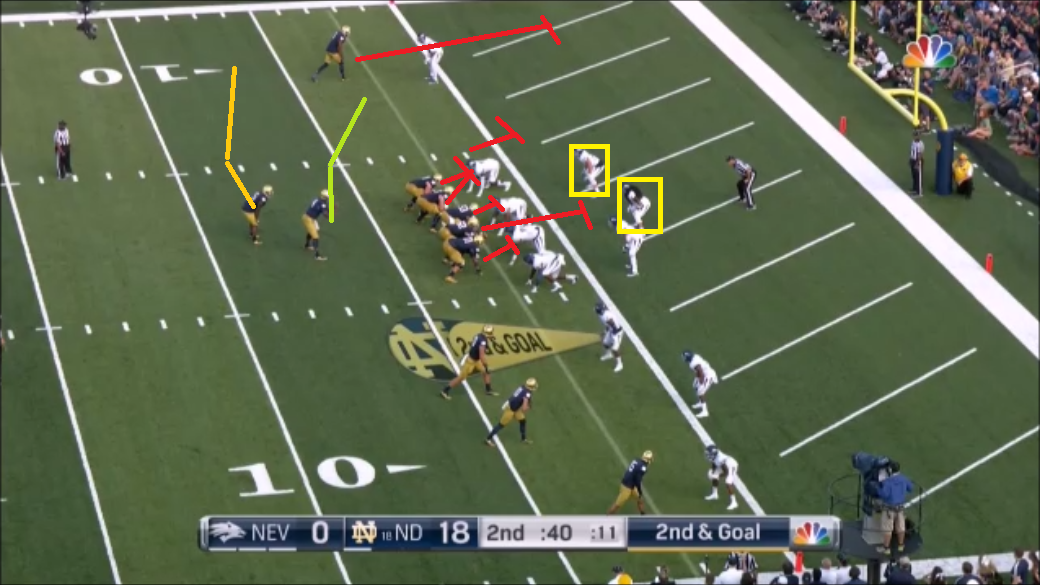
Against Nevada in the red zone 2nd and goal from the 3, Kizer audibled into the speed option. The reason for the audible was likely that there were 3 perimeter defenders (the corner, the outside linebacker and the defensive end) responsible for five players on offense (Kizer, Tarean Folston (#25), Equanimeous St. Brown (#6), Mike McGlinchey (#68) and Quenton Nelson (#56)).
The read key is a bit difficult to determine, but likely was the outside linebacker or possibly the middle linebacker. McGlinchey and Quenton Nelson double team the playside defensive end before one of them tries to move onto the next level. St. Brown runs off his defender before blocking him. Kizer runs laterally to the 5 yard line with Folston in a pitch relationship.
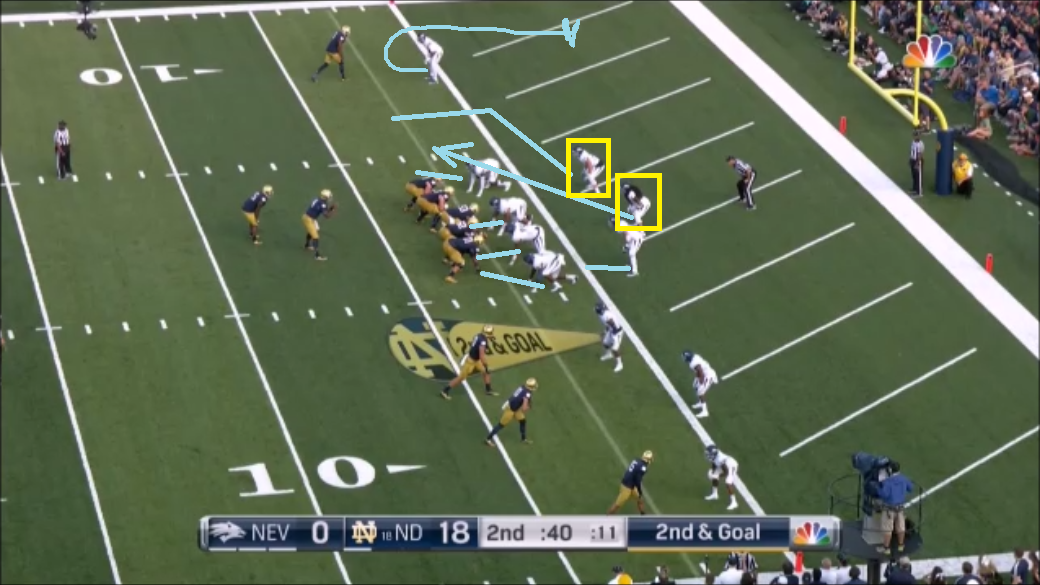
From the alignment of the defense, Nevada is in a bit of trouble. They are out leveraged and out manned horizontally. Additionally, the player responsible for the quarterback has a long way for pursuit. Finally, there is no player responsible for forcing the outside run to cut back, it is likely that the outside corner had dual responsibilities to be the force player and be responsible for his man. In short, the Nevada defense was pretty much beat from the snap.
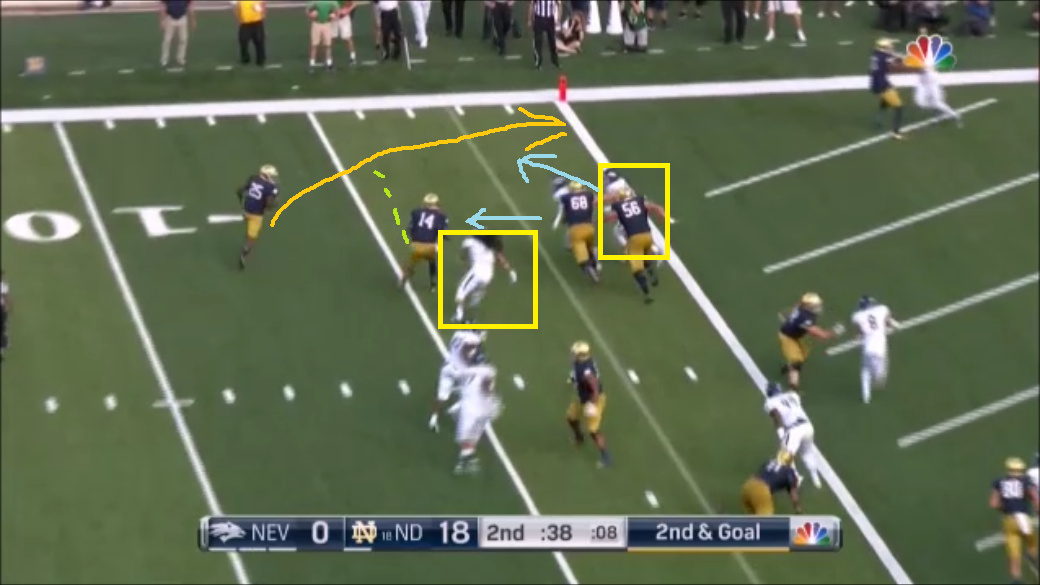
Kizer runs horizontally until the middle linebacker commits to stopping him, after which Kizer pitches the ball to Folston. Meanwhile the outside linebacker, who probably should have been sealed earlier by the Nelson, attempts to play Folston. He (the linebacker) rather inexplicably doesn’t even touch Folston but that is what often happens when you put a greater athlete from Notre Dame against a Nevada defender. All, in all, Nevada either played their cards well or Notre Dame poorly for the touchdown to have been as close as it was. If McGlinchey and Nelson had held onto / made their blocks I possibly could have scored an untouched touchdown on this play.
Whole play here:
Michigan State Lead Option
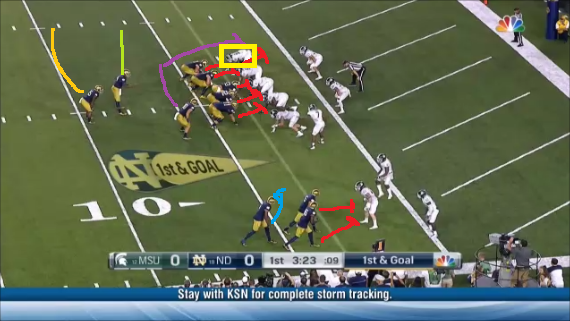
This play is technically called the “lead option” because it has a lead blocker and the defensive end is being read, but for all intents and purposes it is just another speed option. The action from the tight end is set up from the earlier split zone series .
In the play, at the Michigan State 3 yard line Durham Smythe (#80) is aligned in a wing formation. He pulls across formation in order to setup a block on the weak outside linebacker (who followed Smythe across the formation). The read key is the defensive end. Notre Dame again has a defense out leveraged as there is no force player to make the offense cut back into pursuing defenders.This play if blocked and ran correctly should result in an easy touch down.
Mike McGlinchey (#68) moves past the defensive end.. and manages to pretty much block no one. Quenton Nelson (#56) blocks the strongside defensive tackle.
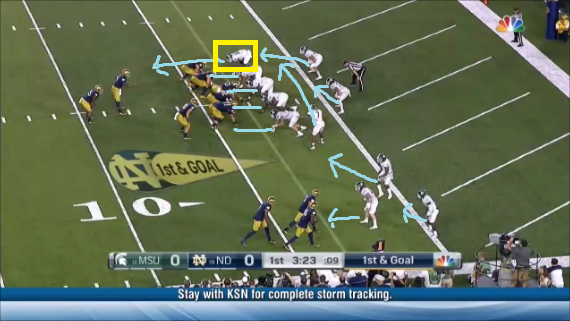
Michigan State has the weakside outside linebacker shadow Durham Smythe across the formation. The outside and middle linebackers follow the flow of the offense.
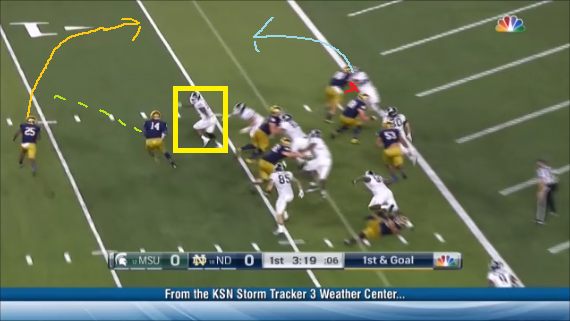
The defensive end plays Kizer which causes a pitch to Tarean Folston (#25). Durham Smythe is in perfect position to block the only remaining MSU defender in a position to stop the touchdown.
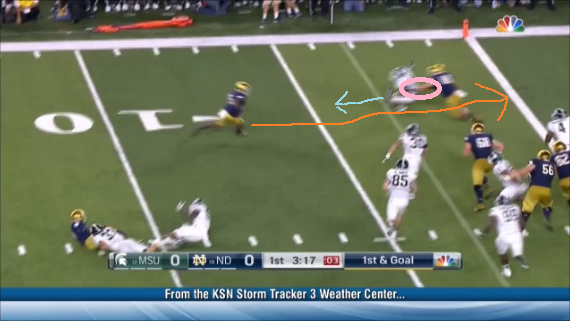
Unfortunately, Smythe is unable to hold his block and very lightly blocks in the back. Folston is able to cut inside of the linebacker, whose momentum was taking him to the boundary of the field. The play results in a touch down.. that is called back for a block in the back. It was a very light call, but technically the right one. Again, if the blocking was ideal this would have gone for a touchdown 100 / 100 times, but football isn’t ideal and players get in bad positions and miss blocks.
And the whole play here:
Duke Speed Option
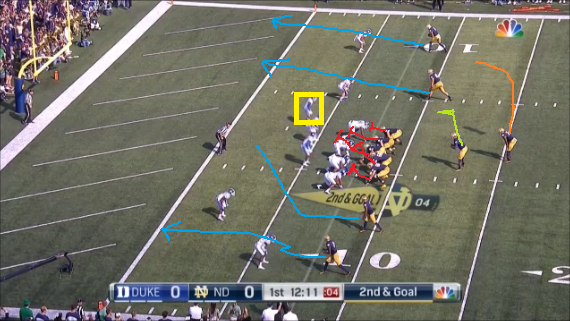
Notre Dame is again in the redzone (2nd & goal from the 8 or so) when they run this speedoption. The read key is the strongside linebacker. Alex Bars (#71) blocks the playside defensive end, Colin McGovern (#62) “blocks” (I use quotations because he did not manage to accomplish much) the middle linebacker. Sam Mustipher (#53) lightly double teams the defensive end before moving onto the next level. Durham Smythe (#80) and St. Brown (#6) run off their defenders before blocking them. Kizer attacks the inner hip of the outside linebacker with Josh Adams (#33) in a pitch relationship.
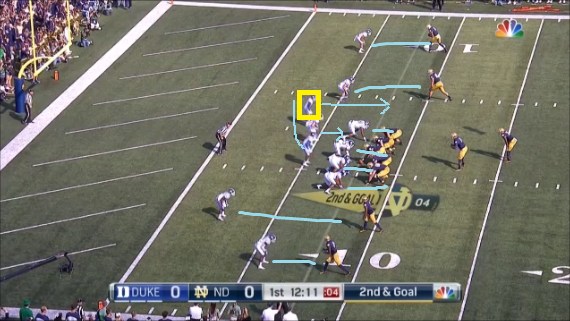
Michgan State’s defenders on Smythe and St. Brown are forced to follow them. The outside linebacker surges toward Folston. The inside linebacker, who should have been blocked, charges downfield and doesn’t manage to accomplish much. The weakside linebacker correctly diagnoses the play and flows to stop the option.
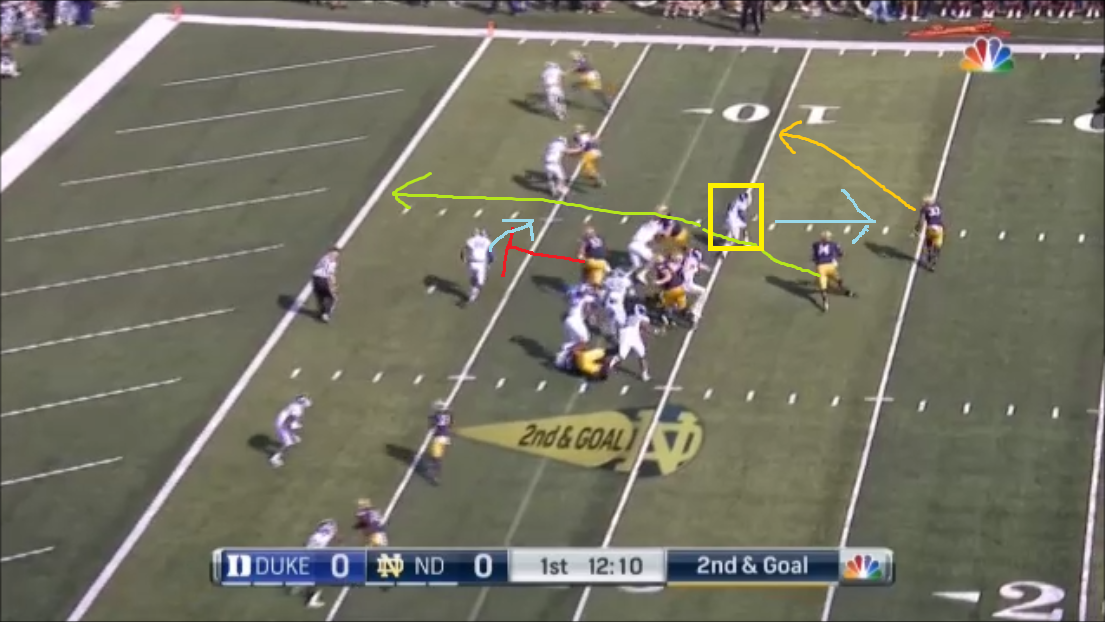
The outside linebacker choose to guard Folston, which causes Kizer to cut upfield.
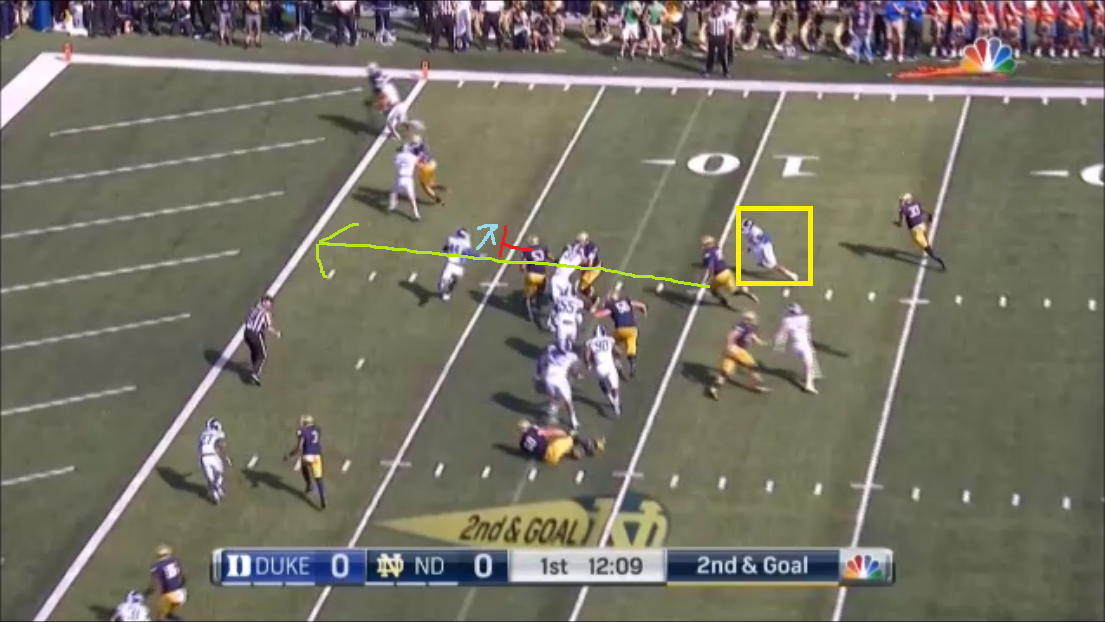
Sam Mustipher (#53) is in perfect position to block the only remaining defender that has chance to stop Kizer, but the linebacker’s momentum carries him out of the play anyways causing Kizer to score easily.
And the whole touchdown is here:
Why is the speed option not called more?
The speed option, while adding a new component to ND’s offense and being immensely successful very often results in the quarterback getting hit. As it appears Brian Kelly is trying to minimize Kizer’s hits, this play is generally only run as an audible in crucial situations or in the red zone. Essentially, Brian Kelly only calls the speed option or allows it to be audibled into when Notre Dame has the defense out leveraged and it is a critical drive or area of the field.
Playlist all speedoptions here
Note the “freeze option” is almost certainly a busted play, so I didn’t count it in the TD percentage
You can follow 18stripes at https://twitter.com/18stripes and me at https://twitter.com/Downinthebend .

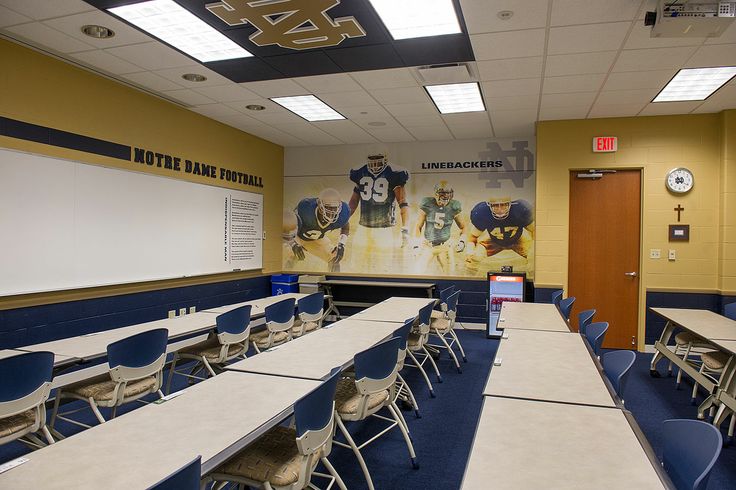
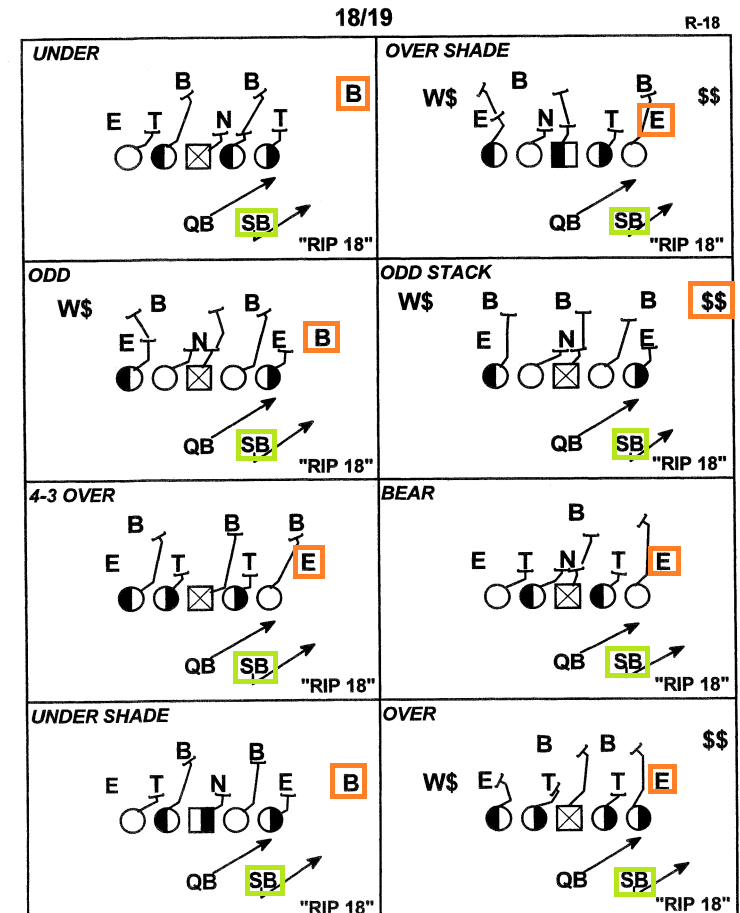
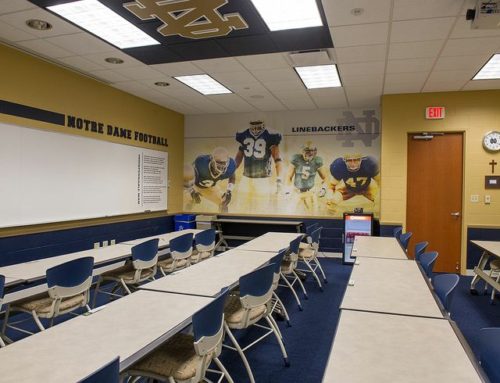
Thanks Downwithebend. Great article buddy. Holy crap Washington looks indomitable. Stanford looks very flawed. Not flawed enough for us to beat, but flawed nonetheless.
Nice analysis. Makes the OL not look very good. I’m not sure if those are difficult blocks – sounds like they aren’t but OL missing blocks on every one of those plays. Makes me wonder about the ones that aren’t so easy.
Nice use of graphics and good explanation. I like how it is basically Youtube wizard meets MS Paint’s left brain. Love the scribbley arrows.
Wow man! i just realized you’re the one i have to thank for the condensed video of each game. Thanks dude!
Love the article!
My all-time favorite variation: I formation triple option in the early 90s. Mirer pivots to the right and has the option of handing it off to Bettis on the FB dive. Then Mirer runs right and has the option of keeping or pitching to Brooks. If the defense keys on the QB or TB, Bettis runs it up the gut right behind the pursuing LBs.